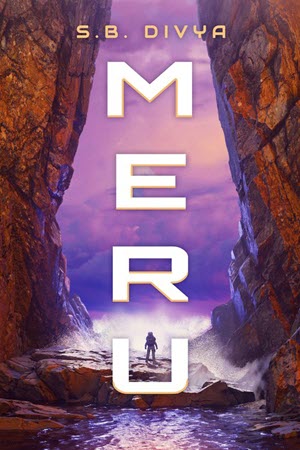Meru
 I’ve heard a lot of good things about Machinehood, but haven’t got around to reading it, so when I saw a new SB Divya novel available I figured I should dive in straight away. I’m pleased I did, because Meru has given me a lot to think about.
I’ve heard a lot of good things about Machinehood, but haven’t got around to reading it, so when I saw a new SB Divya novel available I figured I should dive in straight away. I’m pleased I did, because Meru has given me a lot to think about.
The starting point is that this book is actually science fiction. What I mean by that is that it isn’t just a fantasy story set in a futuristic world. It is a book whose author has thought hard about some scientific and philosophical issues, has put some of those thoughts into the book, and has spun the plot around them. I don’t see that sort of thing too often these days, so I’m pleased when I find it.
Also the world that Divya has created for these books (I understand that there will be sequels) is very interesting. It is set in a fairly far future in which some humans have evolved to literally live amongst the stars. We are not talking sentient spaceships here, we are talking people who have evolved to become spaceships. They are known as “alloys”, and are part machine, part flesh.
Standard humans still exist. However, they are in disgrace. They almost caused the destruction of Earth, and they made a complete mess of trying to terraform Mars. The alloys have determined that humans suffer from Aspiration and Avarice Disorder (AAD); that is, their ambition and greed cause them to spoil any resource they get their hands on. So humans must be managed, because they are naughty children and can’t be trusted to behave. One consequence of this is that they are not allowed to leave Earth.
Something else that is notable about the world of the book is that many of the characters appear to be of South Asian descent. The chapter headings are all in Sanskrit (with English translations). This is refreshingly different.
You may be wondering how the alloys manage to look after the humans if they are spaceships and the humans are all confined to Earth. However, alloys are able to create incarns, android avatars which can visit planetary surfaces. Most alloys can’t fly in atmospheres, but they build machines that can ferry their incarns up and down the gravity well.
Of course not all alloys have the same view of humans. Some are quite fond of the little rascals. And that brings us to our central character. Jayanthi is human, but she was designed and grown, and parented, by a couple of alloys who have chosen to live on Earth to do this. Their true bodies are parked in geosynchronous orbit and they inhabit their incarns full time.
Due to her unusual upbringing, Jaya is rather less cowed than most humans. Her parents can, if they wish, travel to the stars. They can also partake in serious scientific research. She would like to do the same. Everyone tells her that she has terrible AAD and she should be ashamed, because it will only lead to disaster.
At this point, enter Hamsa. He’s an alloy politician who advocates for civil rights for humans. Naturally he is friends with Jaya’s parents. Thanks to him, and to a quirk of her genetic makeup, Jaya is selected for an experiment. The planet Meru is almost Earth-like, and might be habitable. It has no life of its own, so there’s less for humans to wreck. Jaya’s unusual biology makes her better suited than most humans to try living there. She will have a year to prove that she can live safely on Meru, without destroying it in the process.
Naturally Jaya will need support. Most alloys don’t want anything to do with such a politically contentious project, but she enlists the aid of a young ship who has chronic lack of self-confidence and consequently very low scores in zir flying school exams. Vaha was designed by zir parent to be able to fly in atmosphere as well as in-system and between stars, but zie turned out to struggle with all of the various flight modes. Vaha’s parent (alloys only need one parent to design them) abandoned zie in disgust.
So we have two young beings, one human and one alloy, both of whom have had dysfunctional upbringings and have serious hangups as a result. We put them on a planet together, far from any other sentient being. What do we think will happen?
Yep, dead right, this is a book that does what I wish Aliette de Bodard had done with The Red Scholar’s Wake: it undertakes a serious examination of what it means for a human and a sentient spaceship to have a romantic and sexual relationship.
However, that’s not all there is to the book. The politics won’t go away. Hamsa has enemies, some of whom will stop at nothing to ensure that the mission to Meru is a failure, and that humans continue to be confined to Earth. The lives of Jaya and Vaha are of little consequence compared to the need to save the galaxy from humans.
As you can see, there are a whole bunch of deep issues being explored in this book. There are times when I think there’s rather too much explaining what characters feel, and where things happen because the plot needs them to. I could see most of the reveals well in advance. But Divya is clearly a writer with ambition and promise. I’m sure she’ll only get better from here, and I’m going to enjoy following her career.

Title: Meru
By: S B Divya
Publisher: 47 North
Purchase links:
Amazon UK
Amazon US
Bookshop.org UK
See here for information about buying books though Salon Futura